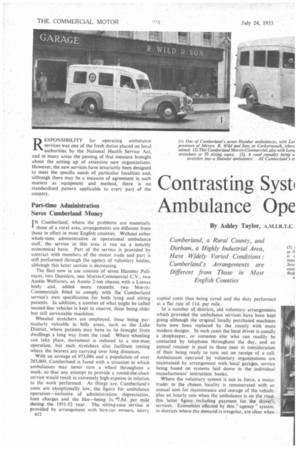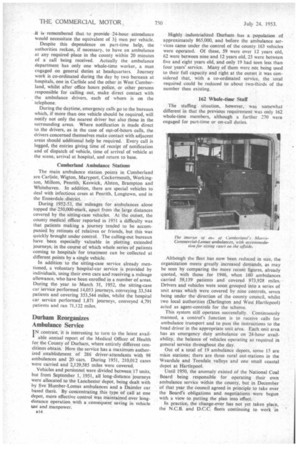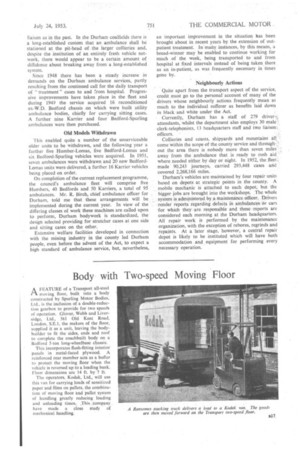Contrasting Syst Ambulance Ope
Page 46

Page 48

Page 51

If you've noticed an error in this article please click here to report it so we can fix it.
Cumberland, a Rural County, and Durham, a Highly Industrial Area, Have Widely Varied Conditions : Cumberland's Arrangements are Different from Those in Most English Counties
By Ashley Taylor, A.M.I.R.T.E. RESPONSIBILITY for operating ambulance services was one of the fresh duties placed on local authorities by the National Health Service Act, and in many areas the passing of that measure brought about the setting up of extensive new organizations. However, the new services have invariably been designed to meet the specific needs of particular localities and, although there may be a measure of agreement in such matters as equipment and method, there is no standardized pattern applicable to every part of the country.
Part-time Administration Saves Cumberland Money
IN Cumberland, where the problems are essentially I those of a rural area, arrangements are different from those in effect in most English counties. Without either whole-time administrative or operational ambulance staff, the service in this area is run On a notably economical basis. Part of the service is provided by contract with members of the motor trade and part is still performed through the agency of voluntary bodies, although this latter section is decreasing.
The fleet now in use consists of seven Humber Pullmans, two Daimlers, one Morris-Commercial C.V., two Austin Welfarers, an Austin 2-ton chassis with a Lomas body and, added more recently, two MorrisCommercials fitted to comply with the Cumberland service's own specification for both lying and sitting patients. In addition, a number of what 'night be called second-line vehicles is kept in reserve, these being older but still serviceable machines.
Wheeled stretchers are employed, these being particularly valuable in hilly areas, such. as the Lake District, -where patients may have to be brought from dwellings a long way from the road. Where wheeling can take place, movement is reduced to a one-man operation, but such stretchers also facilitate resting where the bearers. are carrying over long distances.
With an acreage o1973,086 and a population of over 285,000, Cumberland is faced with a situation in which ambulances may never turn a wheel throughout a week, so that any attempt to provide a round-the-clock service would result in extremely high expense in relation to the work performed. As things are, Cumberland's costs are exceptionally low, the figure for ambulance operation—inclusive of administration, depreciation, loan charges and the like—being ls. 47.8d. per mile during the 1951-52 year. The sitting-case service is provided by arrangement with hire-car owners, heavy,
a12 capital costs thus being saved and the duty performed at a flat rate of 11d, per mile.
In a number of districts, old voluntary arrangements which provided the ambulance services have been kept going although the original locally purchased machines have now been replaced by the county with more modern designs. In such cases the local driver is usually a shopkeeper, or someone else who can readily be contacted by telephone throughout the day, and an annual retainer is paid to these men in consideration of their being ready to turn out on receipt -of a cal Ambulances operated by voluntary organizations are maintainedby arrangement with local garages, service being based on systems laid down in the individual manufacturers' instruction books.
Where the voluntary system is not in force, a motor trader in the chosen locality is remunerated with an annual sum for maintenance and storage of the vehicle, plus an hourly rate when the ambulance is on the.road, this latter figure, including payment fgr the diiVies services. Economies effected by this " agency " system, in districts where the demand is irregular,,are'clear.when it is remembered that 10 provide 24-hour attendance would necessitate the equivalent of 3.1 men per vehicle.
Despite this dependence on part-time help, the authorities reckon, if necessary, to have an ambulance at any required place in the county within 20 minutes of a call being received. Actually the ambulance department has only one whole-time worker, a man engaged on general duties at headquarters. Journey work is co-ordinated during the day by two bureaux at hospitals, one in Carlisle and the other in West Cumberland, whilst after office hours police, or other persons responsible for calling out, make direct contact with the ambulance drivers, each of whom is on the telephone.
During the daytime, emergency calls go to the bureaux which, if more than one vehicle should be required, will notify not only the nearest driver but also those in the surrounding areas. Where notification is made direct to the drivers, as in the case of out-of-hours calls, the drivers concerned themselves make contact with adjacent areas should additional help be required. Every call is logged, the entries giving time of receipt of notification and of dispatch of vehicle, time of arrival of vehicle at the scene, arrival at hospital, and return to base.
Cumberland Ambulance Stations
The main ambulance station points in Cumberland are Carlisle, Wigton, Maryport, Cockermouth, Workington, Millom, Penrith, Keswick, Alston, Brampton and Whitehaven. In addition, there are special vehicles to deal with infectious cases at Penrith, Longtown, and in the Ennerdale district.
During 1952-53, the mileages for ambulances alone topped the 250,000-mark, apart from the large distances covered by the sitting-case vehicles. At -the outset, the county medical officer reported in 1951 a difficulty was that patients making a journey tended to be accompanied by retinues of relatives or friends, but this was quickly brought under control. The calling-out bureaux have been especially valuable in plotting extended journeys, in the course of which whole series of patients coming to hospitals for treatment can be collected at different points by a single vehicle.
In addition to the sitting-case service already mentioned, a voluntary hospital-car service is provided by individuals, using their own cars and receiving a mileage allowance, who have been enrolled in a number of areas. During the year to March 31, 1952, the sitting-case car Service performed 14,053 journeys, conveying 33,544 patients and covering 353,544 miles, whilst the hospital car serviCe performed 1,871 journeys, conveyed 4,791 patients and ran 71,122 miles.
Durham Reorganizes Ambulance Service
IN contrast, it is interesting to turn to the latest avail
able annual report of the Medical Officer of Health for the County of Durham, where entirely different conditions obtain. Here the service has a maximum authorized establishment of 286 driver-attendants with 98 ambulances and 20 cars. During 1951, 210,012 cases were carried and 2,129,585 miles were covered.
Vehicles and personnel were divided between 17 units, but from September 1, 1951, all long-distance journeys were allocated to the Lanchester depot, being dealt with by five Humber-Lomas ambulances and a Daimler car based there. By concentrating this type of call at one depot, more effective control was maintained over longdistance operation with a consequent saving in vehicle use and manpower.
a14
Highly industrialized Durham has a. population of approximately 865,000, and before the ambulance services came under the control of the county 163 vehicles were operated. Of these, 59 were over 12 years old, 62 were between nine and 12 years old, 23 were between five and eight years old, and only 19 had seen less than four years' service. Many of them were not being used to their full capacity and right at the outset it was considered that, with a co-ordinated service, the total required could be reduced to about two-thirds of the number then existing,
162 Whole-time Staff
The staffing situation, however, was somewhat different in that the previous requirement was only 162 whole-time members, although a further 270 were engaged for part-time or on-call duties.
Although the fleet has now been reduced in size, the organization meets greatly increased demands, as may be seen by comparing the more recent figures, already quoted, with those for 1946, when 160 ambulances carried 59,139 patients and covered 973,928 miles. Drivers and vehicles were soon grouped into a series of unit areas which were covered by nine controls, seven being under the direction of the county council, whilst two local authorities (Darlington and West Hartlepool) acted as agent-controls for the scheme.
This system still operates successfully. Continuously manned, a control's function is to receive calls for ambulance transport and to pass the instructions to the head driver in the appropriate unit area. Each unit area has an emergency duty ambulance on 24-hour availability, the balance of vehicles operating as required in general service throughout the day.
Out of a total of 19 ambulance depots, some 15 are main stations; there are three rural out-stations in the Weardale and Teesdale valleys and one small coastal depot at Hartlepool.
Until 1950, the anomaly existed of the National Coal Board being responsible for operating their own ambulance service within the county, but in December of that year the council agreed in principle to take over the Board's obligations and negotiations were begun with a view to putting the plan into effect.
In practice, the change-over has not yet taken place, the N.C.B. and D.C.C. fleets continuing to work in liaison as in the past. In the Durham coalfields there is a long-established custom that an ambulance shall be stationed at the pit-head of the larger collieries and, despite the institution of an entirely fresh vehicle network, there would appear to be a certain amount of diffidence about breaking away from a long-established system.
Since 1948 there has been a steady increase in demands on the Durham ambulance services, partly resulting from the continued call for the daily transport of " treatment " cases to and from hospital. Progressive improvements have taken place in the fleet and during 1949 the service acquired 16 reconditioned ex-W.D. Bedford chassis on which were built utility ambulance bodies, chiefly for carrying sitting cases. A further nine Karrier and four Bedford-Spurling ambulances were then purchased.
Old Models Withdrawn This enabled quite a number of the unserviceable older units to be withdrawn, and the following year a further five Humber-Lomas, five Bedford-Lon-vas and six Bedford-Spurling vehicles were acquired. In 1951, seven ambulances were withdrawn and 20 new BedfordLomas units were delivered, a further 16 Karrier vehicles being placed on order.
On completion of the current replacement programme, the council's ambulance fleet will comprise five Humbers, 40 Bedfords and 50 Karriers, a total of 95 ambulances. Mr. R. Birch, chief ambulance officer for Durham, told me that these arrangements will be• implemented during the current year. In view of the differing classes of work these machines are called upon to perform, Durham bodywork is standardized, the design selected providing for stretcher cases at one side and sitting cases on the other.
Extensive welfare facilities developed in connection with the mining industry in the county led Durham people, even before the advent of the Act, to expect a high standard of ambulance service, but, nevertheless,
an important improvement in the situation has been brought about in recent years by the extension of outpatient treatment. In many instances, by this means, a bread-winner may be enabled to continue working for much of the week, being transported to and from hospital at fixed intervals instead of being taken there as an in-patient, as was frequently necessary in times gone by.
Neighbourly Actions
Quite apart from the transport aspect of the service, credit must go to the personal account of many of the drivers whose neighbourly actions frequently mean as much to the individual sufferer as benefits laid down in black and white under the Act.
Currently, Durham has a staff of 279 driver-attendants, whilst the department also employs 30 male clerk-telephonists, 13 headquarters staff and two liaison officers.
Collieries and coasts, shipyards and mountains all come within the scope of the county service and throughout the area there is nobody more than seven miles away from the ambulance that is ready to rush aid where needed either by day or night. In 1952, the fleet. made 90,243 journeys, carried 293,448 cases and covered 2,268,166 miles.
Durham's vehicles are maintained by four repair units based on depots at strategic points in the county. A mobile mechanic is attached to each depot, but the bigger jobs are brought into the workshops. The whole system is administered by a maintenance officer. Drivers render reports regarding defects in ambulances Or cars for which they are responsible and these 'reports arc considered each morning at the Durham headquarters. All repair work is performed by the maintenance organization, with the exception of rebores, regrinds and repaints. At a later stage, however, a central repair depot is likely to be instituted which will have both accommodation and equipment for performing every necessary operation.




























































































